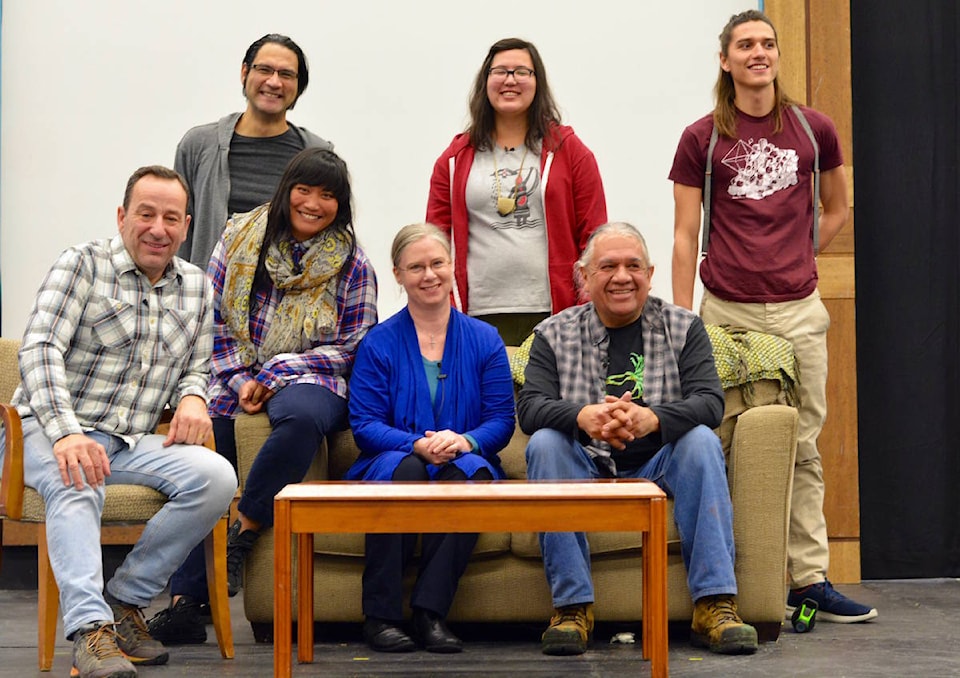A Nelson woman surprised herself and 300 onlookers Thursday night with her intervention in an audience-participation play about reconciliation.
The play, entitled šxʷʔam̓ət (home), is about reconciliation between Indigenous and non-Indigenous communities. Produced by Vancouver’s Theatre for Living, formerly known as Headlines Theatre, it was on a national tour when it stopped in Nelson on Thursday at the L.V. Rogers gym.
Theatre for Living has developed a structured way of allowing audience members to try to solve conflicts between a play’s characters.
“I go to the grocery store,” Lyne Chartier told the Star a few days later, “and people stop me and they are crying, almost. They say, ‘You brought me to tears.’” She seems surprised and puzzled by this.
The piece they performed at LVR is only a half hour long. It covered a lot of bases and set up several conflicts. A young Indigenous man has never been told about his birth family or his past by the white family who adopted him as a baby. The adoptive father is good friends with an Indigenous man who is in conflict with his daughter over her pipeline activism and he’s also the frustrated employer of a troubled young Indigenous man. The pipeline activist daughter challenges the adopted young man on pipeline issues and heritage. One of the daughter’s activist friends is a Filipino immigrant with her own identity issues.
All the characters are reasonable people who do what they do for their own reasons. There is drama and conflict, but no resolution.
Then the technique of audience participation kicks in, facilitated from the stage by David Diamond, who has run Theatre for Living for decades.
The cast runs a short segment of the play again. If an audience member wants to pause the play so they can take the place of one of the actors and change the narrative on the fly, they are asked to yell “Stop.”
The audience member goes to the stage, replaces one of the actors and responds differently from the script. and the other actors have to improvise in response, just for a few minutes. Then they debrief it and move on to another segment with another audience volunteer.
Diamond told the audience he only wanted volunteers who felt they could move through the blockages presented onstage because of their own personal experience.
“It is not to try to make them a better person,” he said. “You should enter the character’s world view, not try to change them.”
Chartier was one of the audience members who took the challenge.
An Indigenous father, Joe, played by Sam Seward, refuses to support his college student daughter taking time off school to help organize a pipeline protest. They argue and he is adamant but won’t tell her why. She asks him to open up to her, tell her about his past, asking him why he has never taught her his language.
“She was asking her dad to love her, without actually saying that,” said Chartier. “When I saw that scene, I thought I understood that guy perfectly clearly, and I thought right then that I should go up. But I got really nervous.”
Chartier told the Star later that her own father was a “Duplessis child,” one of thousands of orphaned children who were given to the Catholic church in Quebec in the 1940s and 50s.
“The church raised him,” she said. “He would not talk about it.”
Chartier, a small, young white woman, took the place on stage of Seward, a big, elderly Indigenous male actor. Chartier, now in character as the father, slammed the table with her hand, twice, and shouted angrily.
“I got angry,” Chartier says, “because I thought she was an amazing teenager that has to go and do her connection with the land. And I got angry because I (the father character) did not want to think about this or talk about it.”
But Chartier said she knew it was time for him to break the blockage. “He had to do it.”
Chartier, as the father, broke down and told his daughter how a residential school had taken his language, separated him from his mother, and that he did not know what to do or how to talk about it.
“He really had to tell her he loved her and it was really hard, maybe the first time ever he had told her. When the daughter told me (the father) she was sorry, I almost cried right there. I thought, ‘OK I want to go home now, I’m done.’”
Chartier says the experience has had a strong effect on her, but she says she has not quite worked out how to express it.
“Something about courage, and about understanding people, and being more out there when you understand someone. Because not everyone understands the same.”
